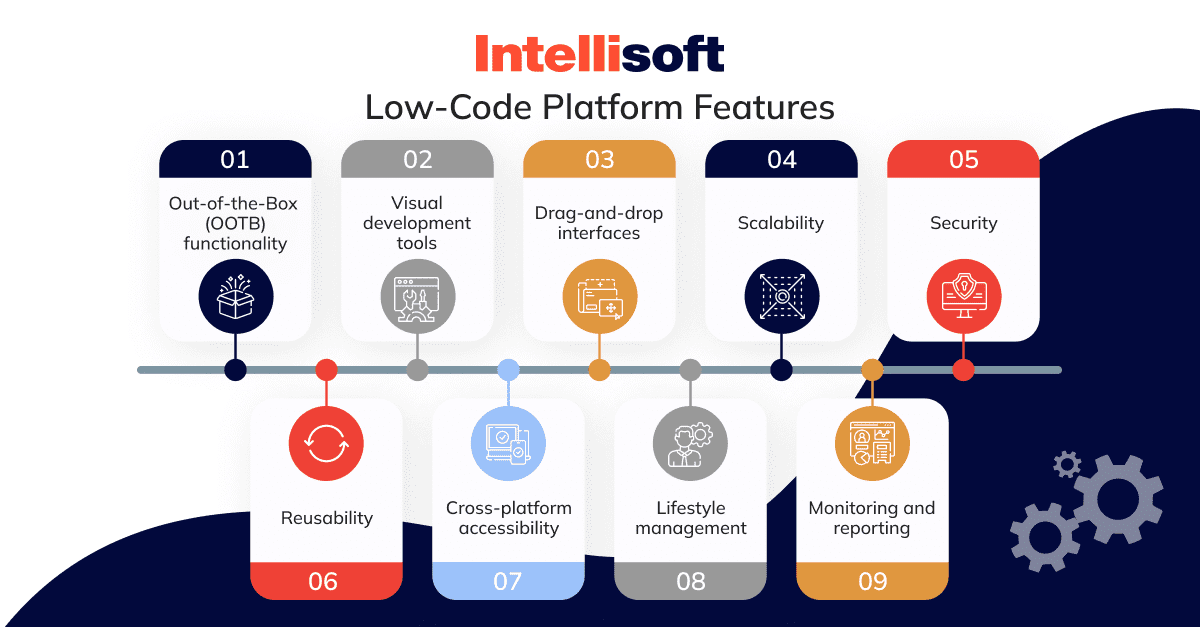Great Ideas On Deciding On Legacy application modernization with Low-code
Great Ideas On Deciding On Legacy application modernization with Low-code
Blog Article
Advantages Of Low-Code Application Development In Terms Of Integration Capabilities
Low-code integration of applications has many advantages, including the capability to seamlessly integrate multiple platforms and services. Here are some of the main benefits of APIs and connectors that are pre-built.
A Wide Range of Connectors: Low-code platforms typically come with a vast library of prebuilt connectors to the most popular enterprise systems (e.g. ERP, CRM, databases, and cloud services). This makes it easier to integrate with these systems.
API Integration: A lot of Low-Code platforms include out-of box API integration capabilities that allow developers to effortlessly connect external services as well as data resources.
Simple to use:
Drag-and–Drop Integration Integrations are created with drag and drop interfaces. Both developers and non-developers are able to accomplish this without having to write a lot of code.
Visual Workflow Designers: These software tools assist you in understanding and implementing integrations more easily.
Standardized Integration Methods:
SOAP and Restful Services: Using standard web service protocols such as SOAP or REST allows you to integrate with other systems and applications.
OData and other Standards Support for other standards like OData enables easy access and manipulation of data across a variety of platforms and software.
Real-Time Data Synchronization:
Real-Time Integrations: Lowcode platforms are able to manage data synchronization in real time between the system and applications to ensure that data is up-to-date and consistent throughout an organization.
Event-Driven Architectures: Some platforms have event-driven architectures which enable applications to respond in real-time when events occur, which is essential for applications that are dynamic.
Legacy System Integration:
Low-code platforms are frequently employed to integrate systems from the past. This lets organizations upgrade IT infrastructures without the need for a complete overhaul of the existing systems.
Data Migration Tools: Built-in data migration tools assist in the transfer of data from older systems to new software built using low-code platforms.
Third-Party Integration of Service:
Cloud Services Integration: The seamless integration of cloud services like AWS Azure, Google Cloud facilitates the easy deployment and scaling-up of applications.
Business Integration of Applications: Low code platforms can be integrated with different business software like Salesforce, SAP and Microsoft Dynamics. This allows for a seamless workflow between different business functions.
Simplified Data Processing
Unified Data Modells: Some lowcode platforms have unification of coding models that simplify the management of data, integration and synchronization across different systems.
Data Connectors: Data connectors that are pre-configured to allow easy access to and manipulation of data from various sources.
Security and Compliance
Secure Integrations Low-Code platforms are designed to ensure that all integrations adhere to the security standards and protocols. This helps protect the data in transit as well as when it's stored.
The platforms include features that ensure integrations comply with regulatory requirements (e.g. GDPR, HIPAA), giving businesses who handle sensitive data security.
Extensibility:
Custom Code and Scripts Low-code platforms tend to support more complex integrations by allowing the inclusion of scripts and custom codes. This allows flexibility without compromising ease of usage.
Plug-in Ecosystems. A community of extensions and plug-ins will allow you to increase the integration abilities, adding new features whenever you need to.
Overall, integration capabilities within low-code development platforms enable them to function as a strong platform to create integrated efficient, scalable and connected applications. They allow you to connect disparate systems. They also enhance data flow. Check out the recommended helpful resource for site info including driver jdbc, push notifications, push alerts, rad application development, app dev platform, cross platform app dev, no code platforms, rapid app development, app development platform, multiplatform mobile app development and more.
Low-Code Software Is Cost-Effective.
Low-code apps offer a number of advantages, such as cost-effectiveness. This is an appealing alternative for companies looking to reduce development costs without sacrificing quality. Here are some of the main advantages:
Low-Code Platforms: Low-code platforms cut down on the amount of hand-coding required, which in turn reduces the time and energy spent by developers in the process of creating applications. This means lower costs for labor.
Less Developer Resources: Because low-code development is faster and easier, fewer developers are needed. This reduces the need for costs of recruiting and retaining personnel.
Faster Time To Market
Accelerated Development: Low-code platforms include visually-based development tools, components that are pre-built, and other features that enable rapid development of software. Businesses can introduce their products to the market more quickly. This can lead to faster revenue generation and a better competitive positioning.
Rapid Prototyping: Businesses can quickly develop prototypes and then test them, which can cut down the time required in the development stage and allowing for faster iterations based on user feedback.
Lower Maintenance Costs:
The modular design and standard components of applications developed with low-code platforms make them easy to maintain. This lowers the costs of maintenance on a regular basis.
Automated Updates. Many low-code platform handle patches and updates automatically. Applications remain safe without the need for extensive manual input.
Efficient Resource Utilization:
Contributions from non-developers Low-code platforms permit business users and non-developers alike to participate in the development process. This allows businesses to leverage the skills of a wider range of employees, while reducing dependence on high-paying developers.
IT Departments can Focus on Strategic Initiatives: Instead, of being caught up in routine development tasks, IT departments can focus their energies on strategic initiatives that improve the efficiency and productivity of their departments.
Price models that are scaleable:
Subscription pricing: Many low-code platforms offer flexible pricing plans for subscriptions that can be scaled according to usage. This allows business to match spending to actual requirements and growth while avoiding large upfront costs.
Pay-Ass-You-Go Options: Certain platforms have pay-ass-you go options that make sure businesses only pay when they make use of resources. This is especially beneficial for small and start-up companies with small budgets.
Costs of Third-Party Software reduced:
Low-code platforms are built-in with functions and integrations, which can lower the cost of software subscriptions and licensing.
Pre-Built Integrations: The availability of pre-built integrations to well-known systems and services reduces the need for the need for custom-designed development. This saves time as well as cash.
Higher ROI
Increased Return on Investment Accelerating development and lower costs and a quicker time to market, companies are able to get a higher return on investments (ROI).
Increased Agility: Companies are able to swiftly adapt to changes in market and the changing needs of customers. This lets them stay current and take advantage of opportunities that come up.
Train for Less:
User-Friendly interfaces: Low-code platforms offer user-friendly and intuitive interfaces that cut down on the time required to learn. They also minimize the need for lengthy training programs.
Accessible resources: Many low-code platforms have comprehensive tutorials, training materials, as well as community support and help, which can reduce the need for formal education.
Collaboration is simplified:
Improved Collaboration Tools: Inbuilt collaboration tools facilitate better communication and coordination between team members, resulting in better development processes and a reduction in project costs.
Unified Development Environment. A single integrated software development environment can simplify processes and decrease the complexity and cost of managing different software and platforms.
The efficiency of low-code application development comes from its ability reduce maintenance and development costs, speed up time to market, optimize resources, and also offer flexible pricing models. These aspects provide significant financial rewards to businesses. Low-code development is an excellent option for businesses that want to make the most of their budgets, but also develop robust, scalable and high-quality software. Have a look at the best Legacy application modernization with Low-code hints for more examples including develop web application, rapid app development, no code platforms, develop web app, software for app development, paas service, developing mobile apps, azure sql, app platforms, cross platform mobile app development and more.
Community And Support From The Vendor Are Two Benefits Of Low Code Application Development.
Low-code platforms have significant advantages both in terms of community involvement and vendor support, both of which are crucial to the successful installation, maintenance and enhancement of software. These are the main benefits: Support
Comprehensive Technical Support:
Support Teams: Several platforms that use low-code provide designated support teams that can assist with technical problems as well as troubleshooting and advice.
24/7 Support: Some vendors are available all hours of the day This is useful for companies operating in different time zones.
Training and Onboarding
Structured Training: A number of providers offer structured training including webinars, tutorials, and certification courses that aid users in becoming comfortable with the platform.
Personalized onboarding: Many vendors have personalized services for new customers helping them to set up the platform in a proper manner and customize it to meet their specific needs.
Regular updates and enhancements
Continuous Improvement: Low-code platforms manufacturers often release regular updates that include new functionality as well as performance improvements and security patches. These updates ensure that their platform is current and secure.
Feedback Integration: A lot of vendors incorporate user input into their development cycles. This helps ensure that the platform adapts to the ever-changing needs and wants of their users.
Comprehensive Documentation:
Documentation is detailed: Users are usually able to access a wealth of well-organized documents that range in terms of complexity from basic modification to advanced.
API References API documentation contains detailed API references to help developers connect their low-code platform apps with other platforms.
Consultancy and Professional Services
Expert Consultation: Vendors frequently offer consulting services to assist with planning for strategic purposes as well as design of architecture and complicated implementations, to ensure that users have the ability to leverage the platform to its maximum potential.
Custom Development Service: Some vendors offer custom development to build features or integrations for their customers that aren't readily available.
Community Support for the Community
Active User Communities:
Forums and Discussion boards Forums and Discussion boards: Many low-code platforms provide active online communities for users to discuss ideas, discuss questions and collaborate.
User Groups and Meetups: User groups, both virtual and local and meetups offer opportunities to meet, network and sharing your experiences with other users.
Knowledge Sharing and collaboration:
Community-Contributed Resources: Users often share templates, modules, and extensions that they have developed, which can be reused or adapted by others, accelerating development and innovation.
Crowdsourced Problem Solving: The collective wisdom and experience of the crowd can be a valuable resource for troubleshooting issues and figuring out creative solutions for complex problems.
Learning and Development
Community-Led training: Many communities offer workshops, webinars and training sessions led by experts in the field.
Tutorials and online courses: Community members often create and share online courses, tutorials and guides on how-to, improving the learning resources for all users.
Feedback and Influence
Product Feedback: Several community forums allow users to provide feedback to vendors. This feedback can affect the design of new features or improvements.
Beta Testing Programs - Active members of the community may be able to take part in the beta testing program. This gives them an early look at new features and also the chance to influence the evolution of the platform.
Recognition and Support:
Community Recognition Programs: Many vendors offer recognition programs to recognize the contribution of active members of the community, such as MVP (Most Valuable Professional) programs.
Peer Support Peer Support: Community members often offer peer support through sharing their knowledge and offering guidance for users who are not as skilled. This creates a supportive friendly and supportive environment.
Overall the combination of strong support from the vendor and an active connected community offers a comprehensive support ecosystem for development of low-code applications. It ensures that the users can access the tools as well as the expertise and collaboration opportunities required to effectively create, deploy, and maintain their applications, ultimately enhancing productivity and innovation.